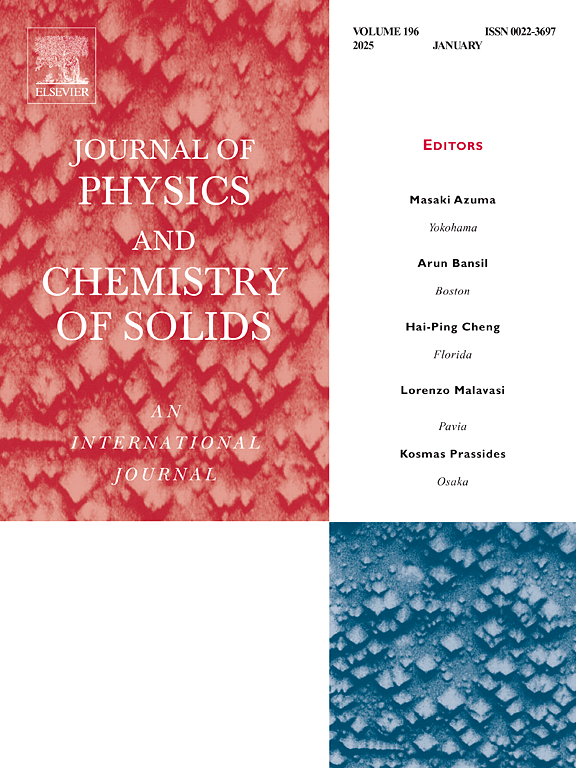Rapid screening strategy for aluminum-ion battery cathode materials using data-driven filtering and Ab initio calculations
IF 4.3
3区 材料科学
Q2 CHEMISTRY, MULTIDISCIPLINARY
引用次数: 0
Abstract
The development of high-performance and cost-effective cathode materials is critical for advancing aluminum-ion battery (AIB) technology as a sustainable alternative to lithium-ion batteries. In this study, we employed a rapid screening strategy that integrates data-driven filtering with ab initio density functional theory (DFT) calculations to accelerate the discovery of promising AIB cathodes. Utilizing an extensive dataset of over 154,500 inorganic compounds from the Materials Project (MP) database, candidate materials were systematically evaluated based on criteria including thermodynamic stability, theoretical specific capacity, electrical conductivity, environmental compatibility, and economic feasibility. This approach led to the identification of six promising cathode materials: AlCuS2, AlCuSe2, AlFe2O4, AlFeO3, AlVO3, and AlMnO3. Among these, AlFeO3 and AlMnO3 emerged as the most promising candidates, exhibiting outstanding electrochemical performance with high specific capacities (614.59 mAh/g and 618.88 mAh/g, respectively), significant operating voltages (3.61 V and 3.41 V), and superior energy densities (2218.67 Wh/kg and 2110.38 Wh/kg). These materials also demonstrated minimal volume changes during charge-discharge cycles, ensuring structural stability for long-term battery operation. Additionally, AlCuS2 and AlCuSe2 were identified as viable cathodes for aqueous electrolyte systems due to their lower operating voltages. The results highlight the efficacy of combining computational screening with ab initio calculations in expediting cathode material discovery. This study provides a pathway for future experimental validation and further optimization, paving the way for the development of next-generation AIBs with improved performance, sustainability, and economic viability.
基于数据驱动滤波和从头算的铝离子电池正极材料快速筛选策略
开发高性能、高性价比的正极材料对于推动铝离子电池(AIB)技术成为锂离子电池的可持续替代品至关重要。在这项研究中,我们采用了一种快速筛选策略,将数据驱动滤波与从头算密度泛函理论(DFT)计算相结合,以加速发现有前途的AIB阴极。利用材料项目(MP)数据库中超过154,500种无机化合物的广泛数据集,候选材料根据热力学稳定性、理论比容量、电导率、环境兼容性和经济可行性等标准进行了系统评估。该方法鉴定了六种有前途的正极材料:AlCuS2、AlCuSe2、AlFe2O4、AlFeO3、AlVO3和AlMnO3。其中,AlFeO3和AlMnO3表现出优异的电化学性能,具有较高的比容量(分别为614.59 mAh/g和618.88 mAh/g),显著的工作电压(3.61 V和3.41 V)和优越的能量密度(2218.67 Wh/kg和2110.38 Wh/kg)。这些材料在充放电循环过程中也表现出最小的体积变化,确保了电池长期运行的结构稳定性。此外,AlCuS2和AlCuSe2由于其较低的工作电压而被确定为水电解质系统的可行阴极。结果强调了将计算筛选与从头计算相结合在加速阴极材料发现方面的有效性。该研究为未来的实验验证和进一步优化提供了途径,为开发具有更高性能、可持续性和经济可行性的下一代aib铺平了道路。
本文章由计算机程序翻译,如有差异,请以英文原文为准。
求助全文
约1分钟内获得全文
求助全文
来源期刊
CiteScore
7.80
自引率
2.50%
发文量
605
审稿时长
40 days
期刊介绍:
The Journal of Physics and Chemistry of Solids is a well-established international medium for publication of archival research in condensed matter and materials sciences. Areas of interest broadly include experimental and theoretical research on electronic, magnetic, spectroscopic and structural properties as well as the statistical mechanics and thermodynamics of materials. The focus is on gaining physical and chemical insight into the properties and potential applications of condensed matter systems.
Within the broad scope of the journal, beyond regular contributions, the editors have identified submissions in the following areas of physics and chemistry of solids to be of special current interest to the journal:
Low-dimensional systems
Exotic states of quantum electron matter including topological phases
Energy conversion and storage
Interfaces, nanoparticles and catalysts.

 求助内容:
求助内容: 应助结果提醒方式:
应助结果提醒方式:


